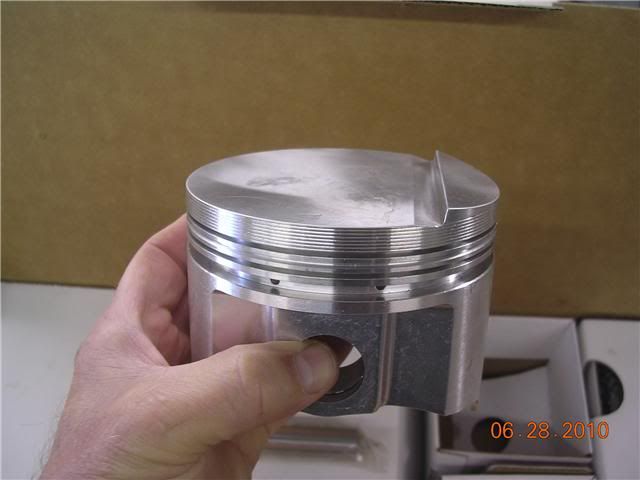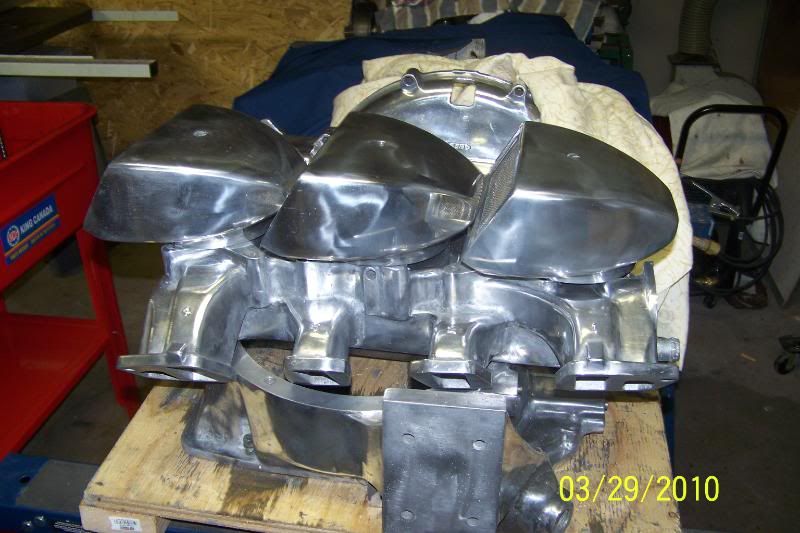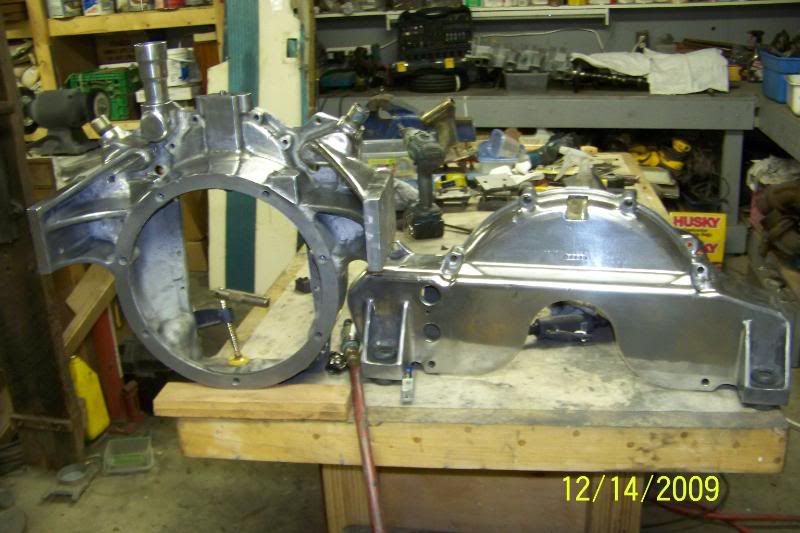Announcement
Collapse
No announcement yet.
430 Pistons MEL Engines
Collapse
X
-
430 Pistons MEL Engines
Member, Sons of the American Revolution
CLICK HERE to see my custom hydraulic roller 390 FE build.
"We've got to pause and ask ourselves: How much clean air do we need?"
--Lee Iacocca
From: Royal Oak, MichiganTags: None -
I spoke with Mike (owner of my engine machine shop, D&S Engine Specialists), and he is confident that we can get correct pistons for the 430.Vern, I'd love to say, 'yes', but I can't. I was tempted to do just that until I learned about the consequences.
You described exactly what happens in a cylinder, it tapers. Installing new rings on a tapered bore will cause the rings to rapidly expand and contract, billions of times. It would work, but not for very long. In a short time, the rings would cause excessive piston groove wear and ring-top wear or they can break. Even if you tried setting the end gap at the bottom of the cylinder to .017" (at the smallest diameter), by the time the rings made it to the top, the end gaps would be open too much.
Old rings are half worn away, have less compression, and really don't flex with much outward pressure. The end gaps are about .100" wide, and the smooth cylinders cause them to hydroplane (and burn oil).
So, what are the options... You can bore and sleeve the cylinders. All aluminum engines have sleeves pressed into the bores, so this is a common practice. After honing the sleeves to the size of your old pistons, they would work just fine. I would do that if your 430 were mine.
Otherwise, a standard oversize bore and new pistons would be in order. I realize aftermarket pistons do not have the same contour as your stock pistons. If you get a group of owners together, you could probably convince a piston company to make a 'run' of pistons for the 430, but they would need to be all the same size. I will call my engine machine shop and ask how much sleeving costs.
But to answer your question directly; considering the cost of a major overhaul, using old pistons in the same bore is not worth it. Please realize, the used piston-to-used bore clearance is sloppy at .0025" (Ford's max limit). New piston in a new bore is spec'ed at .0015" (1-1/2 thousandths of an inch). The difference is only one thousandth.
By the time a typical engine is ready for an overhaul, the 'bell shaped' cylinder will be many thousandths wider at the top (you can use the 'ridge' as a witness mark for measurement).
Bottom line is... if you're spending that much to do a major, might as well do it once and do it right. Expect to spend around $1,500 for parts and machine shop costs. Then you assemble and install it, and save at least another $1,500.
Most of our squarebirders who restore their own engines, spend extra time to do things right. When done, their engines work even better than the production engine their Tbird came with. - Dave
Mike is asking me to bring an original piston to him.
If you have an old 430 piston, please PM me.
I would like to borrow it, then I'd be glad to send it back if you need it.
I will find out what availability and cost would be for a new set. So, PM me if you have a piston to loan.
Mike said sleeving the engine is far too cost prohibitive, and I'm going in the wrong direction. He doesn't believe anyone should do a major using old, worn, pistions. All of his engines carry an automatic 2-year warranty, so you can understand why his shop uses premium components.Member, Sons of the American Revolution
CLICK HERE to see my custom hydraulic roller 390 FE build.
"We've got to pause and ask ourselves: How much clean air do we need?"
--Lee Iacocca
From: Royal Oak, Michigan -
There has been a lot of discussion on pistons on the MEL engine forum, I have been part of that discussion. Although a number of manufacturers did make stepped pistons for the MEL series engines, most of them stopped based on demand. The pistons available from Kanter, Egge, and a few others are flat tops. This reduces the effective compression ratio from roughly 10:1 to about 7:1 and destroys the swirl in the combustion chamber further reducing performance. The 430 in particular was a VERY high performance engine with a short, yet fabled history. Ford paid particular attention to combustion chamber design, and piston style was big part of it.
In my particular build, which is a marine one, I ordered WISECO forged aluminum pistons with a 9.6 to 1 compression ratio. $1400 dollars. It was a fairly big investment, but overall in the big scheme of things.... not so much. My engine has been renewed completely with a 3 angle valve job, seats, new guides, crank was turned, Wiseco pistons, An original Mercury marauder intake with the 3 holley 2300's, Edelbrock M4 water cooled exhaust manifolds, Moon valve covers, etc etc. While cosmetics are important, a fresh engine costs for things you don't see, but they are the heart of the car/boat etc. I am looking forward to having an engine with a long life ahead of it, and no surprises or downsides.
If you visit the MEL engine forum, you will see a LONNNG thread on piston design etc.
Here are my Wiseco's and a couple of other pics of front and rear cover and polished manifold. Hours, I tell ya Hours.



Comment
-
430 togh as **** !!!
I paid $400.00 for a used 430,1959 model out of a t-bird. I lucked out as all it needed was a set of rings. i did install new lifters, and all gaskets and seals were replaced. (including valve stem seals) .Now I have been a certified ford tech for 45 years, and I know very well that to do it RIGHT, replace evrything. But I gotta say, this engine works very nice in my 1960 T-bird. Has tons of torque, and will run all day long in hot weather and never bothers at all. So in my case, I got by cheap! Sometimes a guy just gets lucky!!! I wanted to use the old but not worn out bearings because all I could find were Chineese replacements. I used Moly rings, seated right away. Point is, if you don't have the money for a complete overhaul, in an engine that is still within normal wear limits, go ahead and use the old pistons or bearings. Years ago, there were plenty of engine re-rung, valves ground, and put back together to go again, that's my 2 cents, probably isn't worth that to some.Comment
-
Correct. Piston wear and cylinder taper limits are given in the shop manual. While a completely fresh engine is nice, it is not necessary for a mild street engine.Point is, if you don't have the money for a complete overhaul, in an engine that is still within normal wear limits, go ahead and use the old pistons or bearings. Years ago, there were plenty of engine re-rung, valves ground, and put back together to go again, that's my 2 cents, probably isn't worth that to some.
The engines of this period are not as technically advanced as today's engines as far as machining and component tolerances.
Does anyone remember the piston ring ridge cleaning tool?Comment
-
I think you are confusing two tools; a piston groove cleaner (to remove carbon deposits in the bottom of each piston groove) and a cylinder ridge reamer (to remove the cast iron 'step' at the top of each bore, left by ring wear).
I used to use a broken piston ring to clean carbon out of the grooves. After so many cuts, I found chemicals like phosphoric and sulphuric acids easily soften and remove carbon.
Vern has the ridge reamer because cylinder wear was so bad the pistons wouldn't come out of their bores. If the bore was that wide, it's time for a re-bore and new pistons (or sleeves). - DaveMember, Sons of the American Revolution
CLICK HERE to see my custom hydraulic roller 390 FE build.
"We've got to pause and ask ourselves: How much clean air do we need?"
--Lee Iacocca
From: Royal Oak, MichiganComment
-
I am presenting confusing information. Your description of the two tools is more concise.Comment


Comment